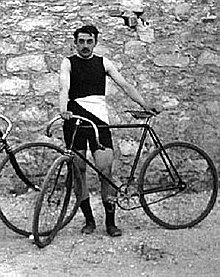
The 1896 Summer Olympics, officially known as the Games of the I Olympiad and commonly known as Athens 1896, were the first international Olympic Games held in modern history. Organised by the International Olympic Committee (IOC), which had been created by French aristocrat Pierre de Coubertin, the event was held in Athens, Greece, from 6 to 15 April 1896.

The men's time trial was one of 5 track cycling events on the Cycling at the 1896 Summer Olympics programme. It was the fourth event on the cycling schedule and was held on 11 April. The first time trial competition was the only time that Olympic time trials were held over the distance of one-third of a kilometre; when the event returned to the programme at the 1928 Summer Olympics the distance was set at one kilometre.

The men's track time trial, a part of the cycling events at the 1928 Summer Olympics, took place at the Olympic Stadium in Amsterdam. Sixteen cyclists from 16 nations competed. Each nation was limited to one competitor. The distance was 1 kilometre. The race was won by the Danish rider Willy Hansen in 1 minutes, 14.4 seconds. Gerard Bosch van Drakestein of the Netherlands took silver, while Dunc Gray of Australia earned bronze. It was the first medal for each of the three nations in the men's track time trial; none had competed in 1896.

The 100 metres at the Summer Olympics has been contested since the first edition of the multi-sport event. The men's 100 metres has been present on the Olympic athletics programme since 1896. The 100 metres is considered one of the blue ribbon events of the Olympics and is among the highest profile competitions at the games. It is the most prestigious 100 metres race at an elite level and is the shortest sprinting competition at the Olympics – a position it has held at every edition except for a brief period between 1900 and 1904, when a men's 60 metres was contested.

The 400 metres at the Summer Olympics has been contested since the first edition of the multi-sport event. The men's 400 m has been present on the Olympic athletics programme since 1896 but nearly seventy years passed before the introduction of the women's 400 m, which has been held continuously since the 1964 Games. It is the most prestigious 400 m race at elite level. The competition format typically has two qualifying rounds leading to a final race between eight athletes.

The 800 metres at the Summer Olympics has been contested since the first edition of the multi-sport event. The men's 800 m has been present on the Olympic athletics programme since 1896. The women's event was first held in 1928, making it the first distance running event for women. However it was not held again until 1960, since when it has been a permanent fixture. It is the most prestigious 800 m race at elite level. The competition format typically has three rounds: a qualifying round, semi-final stage, and a final between eight runners.

The 1500 metres at the Summer Olympics has been contested since the first edition of the multi-sport event. The men's 1500 m has been present on the Olympic athletics programme since 1896. The women's event was not introduced until over seventy years later, but it has been a permanent fixture since it was first held in 1972. The Olympics final and the World Athletics Championships final are the most prestigious 1500 m races at an elite level. The competition format comprises three rounds: a heats stage, semi-finals, then a final typically between twelve athletes.

The 10,000 metres at the Summer Olympics is the longest track running event held at the multi-sport event. The men's 10,000 m has been present on the Olympic athletics programme since 1912. The women's event was added to the programme over seventy years later, at the 1988 Olympics. It is the most prestigious 10,000 m race at elite level. The competition format is a straight final between around 30 athletes, although prior to 2004 a qualifying round was held.

The sprint hurdles at the Summer Olympics have been contested over a variety of distances at the multi-sport event. The men's 110 metres hurdles has been present on the Olympic athletics programme since the first edition in 1896. A men's 200 metres hurdles was also briefly held, from 1900 to 1904. The first women's sprint hurdling event was added to the programme at the 1932 Olympics in the form of the 80 metres hurdles. At the 1972 Games the women's distance was extended to the 100 metres hurdles, which is the current international standard.
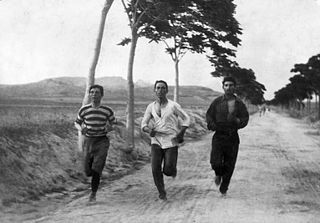
The marathon at the Summer Olympics is the only road running event held at the multi-sport event. The men's marathon has been present on the Olympic athletics programme since the first modern Olympics in 1896. Nearly ninety years later, the women's event was added to the programme at the 1984 Olympics in Los Angeles.
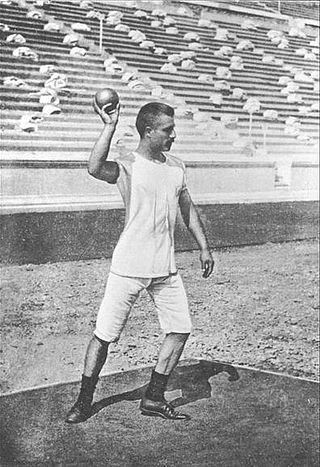
The shot put at the Summer Olympics is one of four track and field throwing events held at the multi-sport event. The men's shot put has been present on the Olympic athletics programme since 1896. The women's event was added to the programme at the 1948 Olympics just over fifty years later.

The discus throw is one of four track and field throwing events held at the Summer Olympics. The men's discus throw has been present on the Olympic athletics programme since 1896. The women's event was first contested at the 1928 Olympics, being one of the five athletics events in the inaugural Olympic women's programme.

The hammer throw at the Summer Olympics is one of four track and field throwing events held at the multi-sport event. The men's hammer throw has been present on the Olympic athletics programme since 1900, becoming the third Olympic throws event after the shot put and discus throw. The women's event was a much later addition, being first contested at the 2000 Olympics.

The javelin throw at the Summer Olympics is one of four track and field throwing events held at the multi-sport event. The men's javelin throw has been present on the Olympic athletics programme since 1908, being the last of the current throwing events to feature at the Olympics after the shot put, discus throw and hammer throw. The women's event was first contested at the 1932 Olympics, becoming the second women's throws event after the discus in 1928.

The pole vault at the Summer Olympics is grouped among the four track and field jumping events held at the multi-sport event. The men's pole vault has been present on the Olympic athletics programme since the first Summer Olympics in 1896. The women's event is one of the latest additions to the programme, first being contested at the 2000 Summer Olympics – along with the addition of the hammer throw, this brought the women's field event programme to parity with the men's.

The high jump at the Summer Olympics is grouped among the four track and field jumping events held at the multi-sport event. The men's high jump has been present on the Olympic athletics programme since the first Summer Olympics in 1896. The women's high jump was one of five events to feature on the first women's athletics programme in 1928, and it was the only jumping event available to women until 1948, when the long jump was permitted.

The long jump at the Summer Olympics, is grouped among the four track and field jumping events held at the multi-sport event. The men's long jump has been present on the Olympic athletics programme since the first Summer Olympics in 1896. The women's long jump was introduced over fifty years later in 1948, and was the second Olympic jumping event for women after the high jump, which was added in 1928.
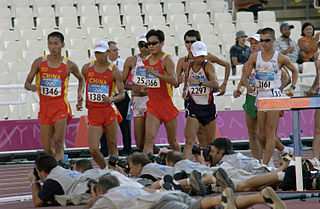
Race walking events at the Summer Olympics have been contested over a variety of distances at the multi-sport event. There were three race walking events in the 2020 Summer Olympics: a men's and a women's 20 kilometres walk, and a men's 50 kilometres walk. The races were held in a final-only format.
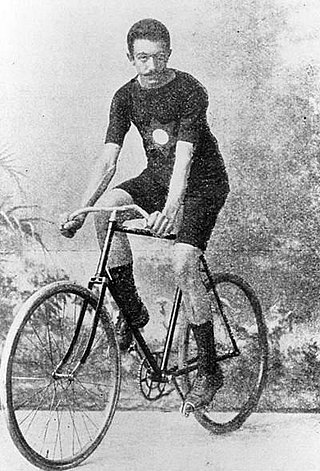
The road race is one of two road bicycle racing events held at the Summer Olympics, the other being the time trial. The road race is a mass start, distinguished from the separate starts of the time trial. The men's road race was first held at the 1896, was not held again for 40 years, then has been held every Summer Games since the 1936 Summer Olympics. The women's event was first contested at the 1984 Summer Olympics, being the first women's cycling event.
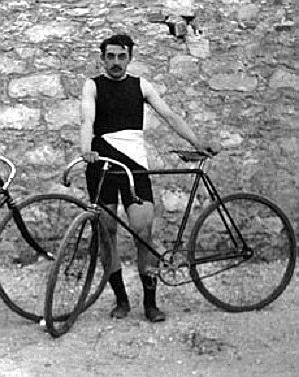
The individual sprint is a track cycling event held at the Summer Olympics. The event was first held for men at the first modern Olympics in 1896. It was held again in 1900, but not in 1904 when various races at different distances were conducted. The men's sprint returned to the programme in 1908 but was again omitted in 1912, when only road cycling competitions were held. After World War I, the men's sprint returned to the programme for good in 1920 and has been held every Games since. The women's sprint was added when women's track cycling was first held in 1988 and has been held every Games since.
